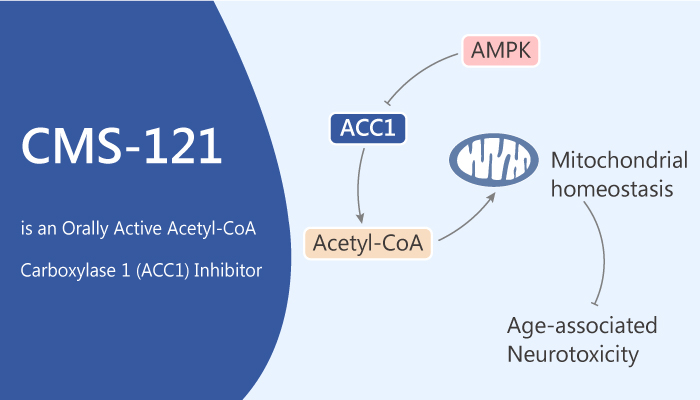Alzheimer’s disease (AD) is a chronic neurodegenerative disease that usually starts slowly and gradually worsens over time. In this study, researchers have identified CMS-121 that is very neuroprotective. In HT22 cells as well as primary neurons, CMS-121 increases the phosphorylation of ACC1 at serine 79. Importantly, CMS-121 also increases phospho-ACC1 levels in the brains of the SAMP8 mice. Moreover, CMS-121 decreases the levels of succinate and α-ketoglutarate.
CMS-121 enhances the levels of acetyl-CoA in cell culture and mice via the inhibition of acetyl-CoA carboxylase 1 (ACC1). CMS-121 reduces cognitive decline as well as metabolic and transcriptional markers of aging in the brain when administered to rapidly aging SAMP8 mice. This effect results in neuroprotection and increased acetylation of histone H3K9 in SAMP8 mice, a site linked to memory enhancement. CMS-121 improves cognitive function in SAMP8 mice when administered at advanced stages of dementia. In addition, CMS-121 increases histone acetylation in neurons.

CMS-121 preserves key brain mitochondrial metabolites during aging. In particular, CMS-121 modulates key metabolites associated with mitochondria in the brain of SAMP8 mice. CMS-121 also
increases acetylation at this site in the mouse brains as well as in primary cortical neurons. Furthermore, CMS-121 is able to reduce age-related cognitive dysfunction, even when administered to SAMP8 mice at a late stage of their lives.
In addition, CMS-121 shares a common mechanism of action that associates with the maintenance of mitochondrial health in terms of transcriptional stability and metabolism. Consistent with these observations, CMS-121 reduces several molecular parameters of brain aging. CMS-121 also suppresses the metabolic drift in the plasma, indicating that CMS-121 may prevent the aging process at the systemic level as well.